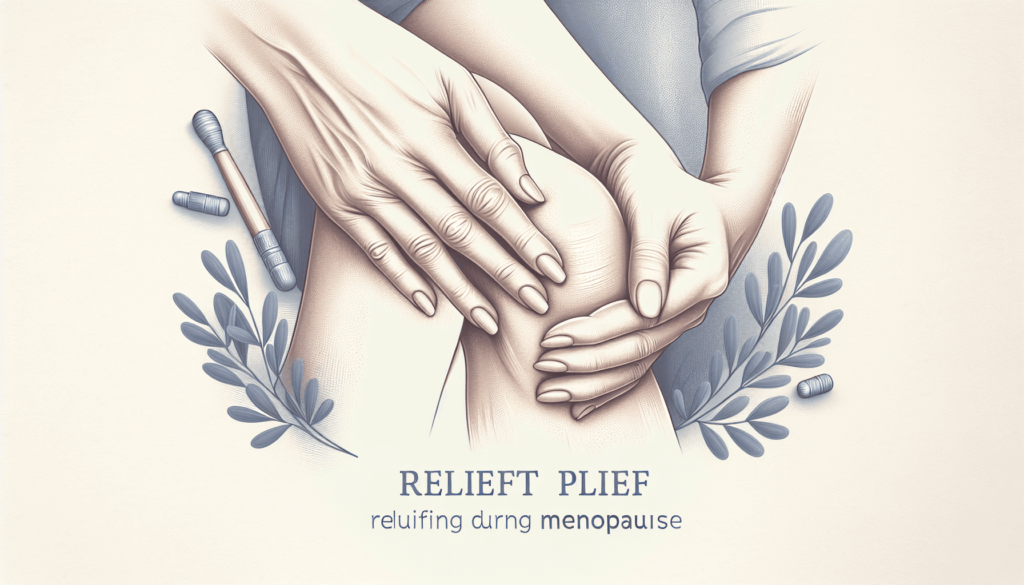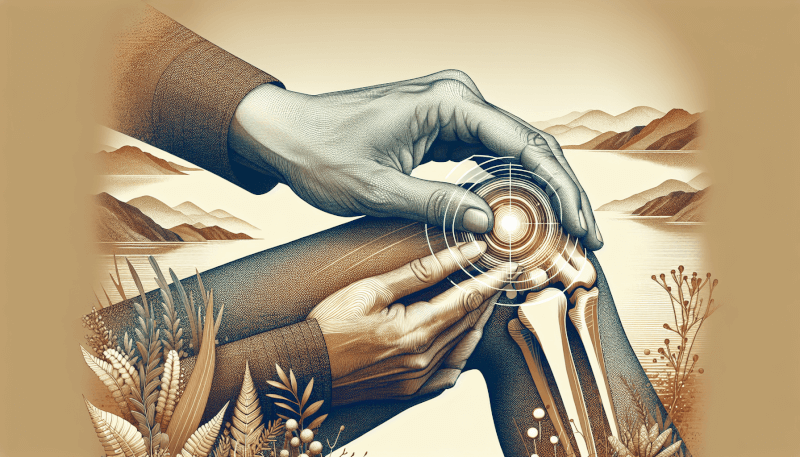Are you experiencing joint pain during menopause? Whether you’re dealing with mild discomfort or debilitating pain, finding natural remedies can offer relief without the side effects of medications. In this article, we’ll explore a range of effective remedies that can help alleviate joint pain during this transitional phase of life. From dietary changes and exercise routines to herbal supplements and alternative therapies, we’ll provide you with practical strategies to manage joint pain and improve your overall well-being. Say goodbye to the discomfort and regain control of your body with these natural remedies for joint pain in menopause.

Overview of Joint Pain in Menopause
Menopause is a natural stage in a woman’s life that marks the end of reproductive years. It is characterized by hormonal changes, including a decline in estrogen levels. While menopause brings about a range of symptoms, one that can significantly impact a woman’s quality of life is joint pain. Joint pain in menopause can be caused by a variety of factors, including hormonal changes, inflammation, and age-related wear and tear. Fortunately, there are several natural remedies available to alleviate joint pain and improve overall joint health during this stage of life.
Exercise and Physical Activity
Regular exercise and physical activity are crucial for maintaining joint health during menopause. Engaging in low-impact exercises can help strengthen muscles around the joints, improve flexibility, and reduce pain. Activities such as swimming, biking, and walking are excellent options that minimize stress on the joints while still providing the benefits of exercise.
In addition to low-impact exercises, incorporating strength training into your routine can be beneficial. Strength training exercises, such as weightlifting or resistance band workouts, help build muscle mass, which provides added support to the joints. Strengthening the muscles around your joints can help alleviate pain and improve joint stability.
Stretching and flexibility exercises are also essential for managing joint pain in menopause. Activities like yoga and Pilates can improve joint flexibility, reduce stiffness, and enhance overall mobility. Stretching helps to promote healthy blood flow to the joints and can provide relief from discomfort.
Herbal Supplements
Several herbal supplements have shown promise in reducing joint pain and inflammation in menopause. These supplements can be a natural alternative to traditional pain medications. Here are a few herbal options to consider:
Turmeric
Turmeric is a spice commonly used in cooking, but it also has powerful anti-inflammatory properties. Curcumin, the active compound in turmeric, has been shown to reduce joint swelling and pain. Adding turmeric to your meals or taking turmeric supplements can help alleviate joint discomfort.
Ginger
Ginger is known for its anti-inflammatory properties and has been used for centuries to reduce joint pain. It contains compounds that help inhibit the production of inflammatory cytokines, which are often elevated during menopause. Consuming ginger in various forms, such as fresh, dried, or in tea, may help soothe joint pain.
Nettle
Nettle, also known as stinging nettle, has been used as a natural remedy for arthritis and joint pain. It contains several beneficial nutrients, including anti-inflammatory compounds that can alleviate joint discomfort. Nettle supplements or teas can be incorporated into your daily routine to relieve joint pain associated with menopause.
Dietary Changes
Making specific dietary changes can also have a significant impact on joint health during menopause. Certain nutrients play a vital role in maintaining healthy joints and reducing inflammation. Here are some dietary recommendations to consider:
Omega-3 fatty acids
Omega-3 fatty acids, found in foods like fatty fish (salmon, mackerel) and flaxseeds, have anti-inflammatory properties that can help reduce joint pain. Including these foods in your diet or taking omega-3 supplements can support joint health.
Vitamin D
Vitamin D plays a crucial role in bone health and can help reduce joint pain. The sunlight is an excellent source of vitamin D, but supplements can also be taken. Including foods rich in vitamin D, such as fortified dairy products, fatty fish, and egg yolks, in your diet can also contribute to joint health.
Calcium
Calcium is essential for strong and healthy bones. Consuming calcium-rich foods like dairy products, leafy greens, and fortified cereals can support joint health and prevent osteoporosis, which can worsen joint pain.
Magnesium
Magnesium is another mineral that plays a crucial role in bone health and muscle function. It works in conjunction with calcium and vitamin D to help maintain joint health. Foods like nuts, seeds, whole grains, and leafy greens are good sources of magnesium.

Hot and Cold Therapies
Hot and cold therapies can provide relief from joint pain and inflammation. These therapies work by improving blood circulation and reducing swelling. Here are a few options to try:
Heat therapy
Applying heat to the affected joints can help increase blood flow, relax muscles, and alleviate pain. Using a heating pad, warm towel, or taking a warm bath can provide relief from joint discomfort.
Cold therapy
Cold therapy, also known as cryotherapy, involves applying ice or cold packs to the affected joints. Cold temperatures help reduce inflammation and numb the area, providing temporary pain relief. Cold therapy is particularly beneficial for acute joint pain or swelling.
Alternating hot and cold therapy
Alternating between hot and cold therapies can also be effective in managing joint pain. This technique, known as contrast therapy, involves alternating between heat and cold treatments. This process can help improve blood circulation and reduce inflammation, providing relief for menopausal joint pain.
Aromatherapy
Aromatherapy, the use of essential oils, can provide natural relief from joint pain in menopause. Essential oils contain aromatic compounds that have been shown to have analgesic and anti-inflammatory properties. A few essential oils that may help with joint pain include:
Lavender
Lavender essential oil is known for its soothing and relaxing properties. It can help relieve muscle tension and reduce joint discomfort. Applying lavender oil topically or using it in a diffuser can provide aromatic relief.
Eucalyptus
Eucalyptus essential oil has anti-inflammatory properties that can help reduce joint pain and swelling. It can be applied topically or used in steam inhalation to alleviate menopausal joint discomfort.
Peppermint
Peppermint essential oil has a cooling effect that can provide temporary relief from joint pain. It can be diluted and applied topically or used in a diffuser to create a refreshing environment that eases menopausal joint discomfort.
Massage and Acupuncture
Massage therapy and acupuncture are non-invasive techniques that can promote joint health and reduce pain. These therapies work by stimulating blood flow, releasing tension, and restoring balance in the body. Here’s how they can help:
Massage therapy
Massage therapy involves applying pressure and manipulating muscles and soft tissues. This can help alleviate muscle tension, increase joint flexibility, and reduce pain. Regular massages can be a valuable addition to any menopausal joint pain management routine.
Acupuncture
Acupuncture is an ancient Chinese practice that involves inserting thin needles into specific points on the body to restore balance and relieve pain. This therapy stimulates the body’s natural healing mechanisms and can reduce joint pain and inflammation in menopause.
Topical Creams and Gels
Topical creams and gels can provide localized relief from joint pain. These products are applied directly to the skin and can help reduce inflammation and ease discomfort. Here are a few options to consider:
Capsaicin cream
Capsaicin is a compound found in chili peppers that has analgesic properties. Applying capsaicin cream to the affected joints can help reduce pain by desensitizing nerve endings. It is important to follow the instructions for use and start with a low concentration to avoid skin irritation.
Arnica gel
Arnica is a herb that has been used for centuries to treat pain and inflammation. Applying arnica gel to the affected joints can help reduce swelling and relieve menopausal joint pain. It is advisable to consult with a healthcare professional before using arnica gel, especially if you have any underlying medical conditions.
Willow bark extract
Willow bark extract contains salicin, a compound that has been used for centuries to relieve pain and reduce inflammation. Applying a gel or lotion containing willow bark extract can provide natural relief from menopausal joint discomfort.
Stress Management Techniques
Chronic stress can exacerbate joint pain and inflammation. Therefore, incorporating stress management techniques into your daily routine can have a positive impact on your overall joint health. Here are a few techniques to consider:
Deep breathing exercises
Deep breathing exercises, such as diaphragmatic breathing, can help reduce stress and promote relaxation. Taking slow, deep breaths can activate the body’s relaxation response, which can alleviate tension in the muscles and joints.
Meditation
Meditation is a practice that involves focusing the mind and observing thoughts and sensations without judgment. Regular meditation can help reduce stress, improve mental well-being, and promote overall joint health during menopause.
Yoga
Yoga combines physical postures, breathing techniques, and meditation to improve flexibility, balance, and mental well-being. Practicing yoga regularly can help reduce stress, increase joint mobility, and alleviate menopausal joint pain.
Other Natural Remedies
In addition to the remedies mentioned above, there are a few more natural approaches to consider for managing joint pain in menopause. These include:
Acupressure
Acupressure involves applying pressure to specific points on the body to relieve pain and promote healing. It is similar to acupuncture but does not involve the use of needles. Acupressure can be practiced on your own or with the help of a practitioner to target specific joints and alleviate menopausal joint pain.
Chiropractic care
Chiropractic care focuses on the alignment of the spine and musculoskeletal system to promote overall health and relieve pain. Chiropractors use manual adjustments and other techniques to alleviate joint pain and improve joint function.
Supplements like glucosamine and chondroitin
Glucosamine and chondroitin are natural substances found in the body’s cartilage. Taking these supplements may help reduce joint pain and improve joint function. These supplements can be found in capsule or liquid form and should be taken as directed.
In conclusion, managing joint pain in menopause requires a holistic approach. Incorporating regular exercise, herbal supplements, dietary changes, hot and cold therapies, aromatherapy, massage and acupuncture, topical creams and gels, stress management techniques, and other natural remedies can provide women with effective and natural relief from menopausal joint pain. It is essential to consult with a healthcare professional before starting any new treatment or supplement regimen to ensure optimal safety and effectiveness. By taking care of your joints during menopause, you can enhance your overall well-being and continue living an active and fulfilling life.


